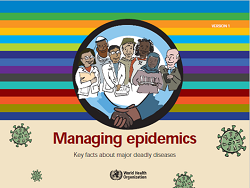Epidemic outbreaks are on the rise, and preparedness in countries and communities to manage these threats is critical to protect health. A new handbook by WHO, with contributions from TDR, gives first responders expert guidance to respond to 15 infectious diseases.
 | A potentially fatal combination of newly discovered diseases, and the re-emergence of many long-established ones, makes this a key tool for WHO country representatives, governments, communities and other public health professionals. The comprehensive, user-friendly handbook, gives key facts and strategies to respond effectively and rapidly at the very start of an outbreak. |
In the foreword, WHO Director-General Dr Tedros Adhanom Ghebreyesus says: “Keeping the world safe is one of WHO’s three top strategic priorities… We are setting ourselves a goal that over the next five years, 1 billion more people will be better protected from epidemics and other health emergencies.”
Toolbox on vector control
A “toolbox” section on epidemic-prone vector-borne diseases such as Zika, yellow fever, chikungunya and plague was developed by TDR scientist Florence Fouque in collaboration with WHO Neglected Tropical Diseases specialists.
It profiles different vectors (ticks, mosquitoes, fleas), their behaviours, biting times and transmission cycles. It includes detailed strategies for personal protection, vector control tools to use in communities, and intervention practices at home and in health care settings to protect human health during epidemics.
More about the handbook
It includes:
- an overview of the epidemics of the 21st century
- 10 key facts about 15 deadly diseases with tips on the interventions required to respond to epidemics of all these diseases; and,
- toolboxes with detailed guidance on topics such as coordination of vaccine provision, laboratory practices for how to collect, diagnosis and store infectious specimens, and transport of infectious substances, in addition to advice on vector control.
For more information, contact Florence Fouque.

